The concept of strategy has been much used and often abused. It is a multi-dimensional concept and has found application in all fields of study and life. Has been defined variously as follows:-
According to Thompson and Strickland, it is ―The game plan management has for positioning the company in its chosen market arena, competing successfully, pleasing customers and achieving good business performance targets‖.
According to Koch Richard (1995), it is ―The commercial logic of a business that defines why a firm can have a competitive advantage‖. Strategy is what a company does and how it actually positions itself commercially and conducts the competitive battle.
Johnson, Scholes &Whittington (2005), ―Strategy is the direction and scope of an organization over the long term, which achieves advantage in a changing environment through its configuration of resources and competences with the aim of fulfilling stakeholder expectations‖.
According to (Pearce & Robinson, 1997) strategy is ―The set of decisions and actions resulting in formulation and implementation of strategies designed to achieve the objectives of an organization.‖
According to (Harvey, 1988) it is ―The process of formulating, implementing and evaluating business strategies to achieve future objectives.‖
Mintzberg (1998), Introduced the 5Ps of strategy. He stated strategy as a:
- Plan
- Ploy
- Pattern
- Position and
- perspective
Strategy as a Plan
• Strategy specifies a consciously intended course of action
• Is designed in advance of the actions it governs
• Is developed deliberately/purposefully
• May be general or specific
Strategy as a Ploy
• Is a specific maneuver intended to outwit a competitor e.g. expansion
• The idea is to outsmart and shed off competitor threat
Strategy as a pattern
• Strategy is a pattern that emerges from a stream of actions
• Is developed in the absence of intentions and without pre-conception
• Is visualized only after the events it governs (emergent)
Strategy as a position
• Is a means of locating an organization in the environment
• Indicates how an organization will develop a sustainable competitive advantage
Strategy as a perspective
• Strategy gives an organization an identity and a perspective
• Reveals the way an organization perceives the outside world
• May be an abstraction which only exists in the mind of some interested party e.g. CEO
Characteristics of Strategy
• Long term direction of an organization
Where are we going?
Organization vision
• Organizational purpose
Defines obligations of the organization to its stakeholders
Defines the goals, objectives and priorities of the organization
• A unifying (integrating) pattern of decisions – a common thread
• Business Domain
Scope of an organization‘s activities
Product/market scope
What the organization will do and what it will not do
• Strategic fit
Matching of activities of an organization to the environment
Organizational positioning
• Competitive advantage
Basis of attracting customers
• Cost leadership
• Differentiation
• Focus
1.2 Levels of Strategy in organizations
• Corporate strategy
Overall purpose and scope of the organization
Overall business domain
Corporate resource allocation
Value addition to the different parts of the organization ( ―2+2=5‖, outsourcing vs core business)
Principal focus – effectiveness.
• Business Strategy
Competition with other businesses in the market. How will we compete successfully
Achievement of competitive advantage
Principal focus is effectiveness
Focus on the Strategic Business Units – SBU
• SBU is that part of the organization for which there is a distinct market for goods and services.
• Distinct market requires different strategies
• Functional (Operational) Strategy
How the various functional areas contribute to achieving business and corporate strategy
Organizational processes
Principal focus is efficiency
• Without strategy, the organization is like a ship without a rudder, going around in circles‖.
Thinking strategically
• How do you know that an organization has a strategy?
• Three key strategic questions:
Where are we now?
Where do we want to go? – what business positions management want to stake out, Financial outcomes to achieve, Strategic outcomes to achieve.
• How will we get there
Formality of Strategy
• A formal strategy is defined by the extent of deliberateness in planning
Identifiable process
Time spend on planning
Documented and Communicated to others.
• Low deliberateness in planning indicates informality.
What factors may influence formality of strategy?
• Organizational factors including growth in size, complexity in products or markets
• External factors including technology, competition, economics,
• Performance – perception of a decline in performance or feeling that a mistake has been made in the past.
What are the benefits of formality of strategy?
• Promotes unity of purpose, direction and commitment
• Forces managers to deliberately think about strategy
• Requires analysis in addition to intuition
• Results in documented strategy
• Communication of strategy is easier.
What are the dangers of formality of strategy?
• Inflexibility
• Creativity and originality may be inhibited
• Time consuming
• Inappropriate executives may be involved.
Strategic management is about success of organizations:
- Profit organizations
- Nonprofit organizations
- Private and Public sector organizations
- Large and Small organizations
- Domestic, multinational, global organizations
Success – Ability to meet expectations of customers who have a choice and Strategic management enhances the chances of organizational success. The ingredient of this success is Organizational vision, clear objectives, understanding the external environment, appreciation of strengths and weaknesses and effective implementation.
It focus is about:
- The future of organizations
- The present posture of organizations
- Developing superior strategy
- Competent implementation of strategy
The key questions to ask are:-
- Where are we now? (situation analysis)
- Where do we want to be? (vision, objectives)
- How do we get there? (strategy)
- What is stopping us? (constraints analysis)
- Implementation
Value of strategic management
- Providing direction
- Vision, mission, objectives
- Framework for company actions
- Adaptation to external change
- Focus on strategic issues
- Competitive advantage
- Effective organization
- Effective resource allocation
- Focus on key issues
Strategy is the link between the organization and its environment
External environment
- Environmental changes shape opportunities and challenges facing organizations in Kenya.
- Need to adjust to these changes to remain successful in future.
- Nature of environmental changes:- Global, regional, national (local).
The questions to ask are:-
- What is the direction of change?
- What is the speed of change?
- What is the response capability of my company
- What is my company doing about these changes?
How companies react to environment?
Analyze the external and internal environment and evolve a strategy for implementation proactive or reactive.
Environmental scanning
External
• PESTEL – Political, Economic, Societal, Technological, Ecological and Legal and regulatory factors
• Competitive environment-Industry Analysis – Porter‘s Model,
• Strategic groups
Internal:
• Organizational Capability analysis- SWOT matrix, Value Chain analysis
• Organization Structure
• Culture (Belief, expectation, Values)
• Resources (Assets, skills, competencies, knowledge)
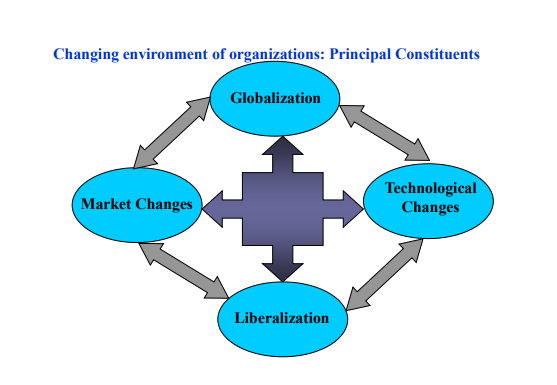
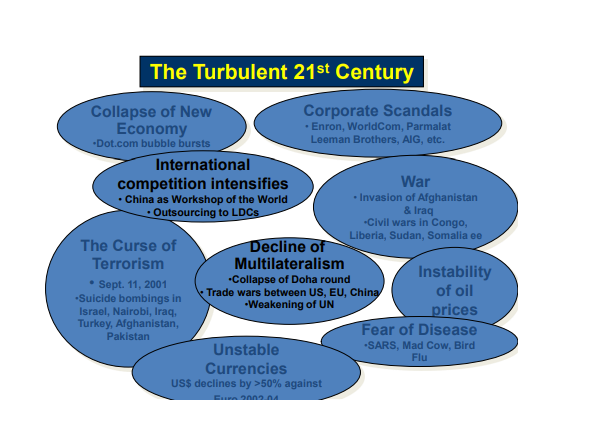
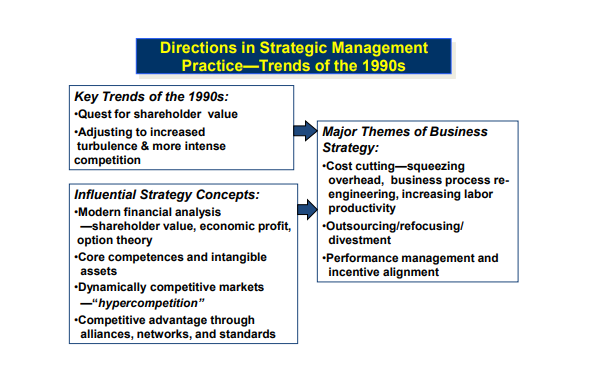
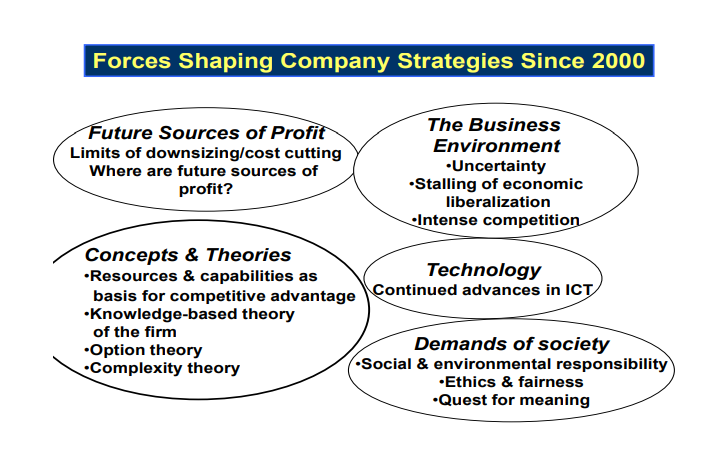
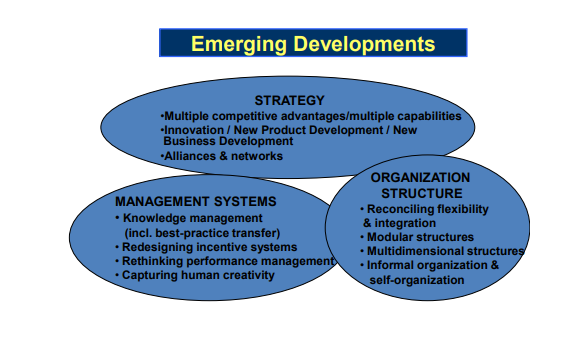
Implications of the dynamics in external environment
• Speed of environmental changes increasing
• Our organizations are very vulnerable
• Increased foreign competition
• Increased local competition
• Appropriate response to environmental change key for future success
• Anticipate change
Respond on a timely basis
VISION AND MISSION OF THE FIRM
- Vision and mission provide direction and scope for the firm‘s activities.
- Vision and mission also provide guidance for the firm‘s strategic objectives and strategies.
Vision:
Vision is usually incorporated in the firm‘s mission document. Vision addresses the question: where do we want to be? This is the first question to be asked in a strategic planning process. Vision refers to what a firm is trying to do or to be i.e. what the firm aspires to be in the future. Vision is the firm‘s ideal future. It is a dream reflecting the best of an organization e.g. the vision of Kenya Airways is to be the “World’s favourite airline‖. A good vision incorporates a level or standard of performance, which level or standard should represent the very best attainable by the organization e.g. ―World‘s favourite‖ for Kenya Airways.
Mission:
While a statement of vision focuses on the future, a mission statement is concerned with the present. Vision refers to what the firm is trying to do, while mission refers to how what the firm is trying to do will be done. For example, what will Kenya Airways have to do in order to be the ―World‘s favourite airline‖? Kenya Airways will have to do the following, among others:
- Provide excellent on-board service.
- Provide excellent inter-connections to any part of the world.
- Provide excellent bookings and reservations.
- Have on-time departures and arrivals.
- Have reasonable fares.
- Provide comfortable flights.
- Provide excellent safety and security.
- Use state-of-the-art aircrafts.
These services would need to be incorporated in Kenya Airways mission statement. What a firm does to realize its vision constitutes the business of the firm i.e. what the firm exists for. A mission statement must be formulated carefully if the vision is to be realized. The following issues or questions, therefore, have to be addressed: What is the firm‘s business? The scope of a firm‘s business may be defined in terms of:
- Products/services
- Markets
- Activities
What are the firm‘s core values? Core values govern how the firm does its business e.g. norms to be observed, and reflect the firm‘s culture and attitude. How will the firm relate to its major stakeholders e.g. customers, employees, government, and the general public? The goodwill of stakeholders is important for a firm in realizing its vision. What corporate policies should the firm adopt? Policies facilitate performance by reducing uncertainty and serving as instruments of empowerment. Everybody in the organization should share and champion the vision and mission of the organization. This requires:
- Incorporating the vision and mission in opening remarks of seminars and workshops.
- Recruiting people with the right aptitude.
- Making vision and mission part of the orientation.
- Recognizing behaviour and performance that gives prominence to the vision and mission.
- Conspicuously displaying the vision and mission within the organization‘s premises.
- Including the vision and mission in the organization‘s pamphlets, bulletins and other publications.